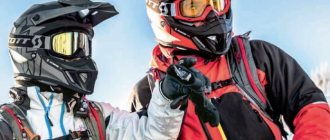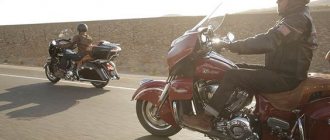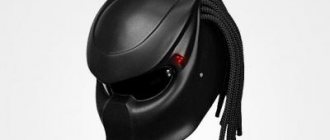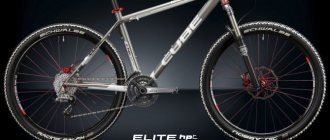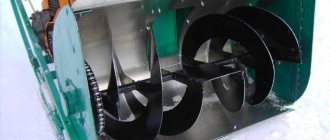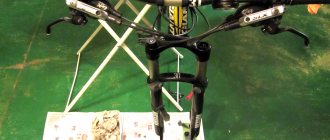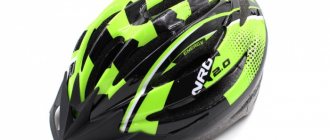MTB, enduro and all mountain are fairly broad concepts of mountain biking, but for the most part they all involve riding on natural trails, downhill riding and overcoming obstacles such as steep climbs, rocks, tree branches and snags.
Helmets for enduro and all mountain can be either open or closed.
Closed (full face) - bicycle helmets with a pad in the jaw area that protect not only the head, but also the face of the cyclist.
Open ones are classic models that protect only the upper part of the head.
Most often, most open MTB helmets are similar to road helmets: they are lightweight, well ventilated, and have a sufficient level of protection. However, they are not as aerodynamic, are equipped with a removable visor and have a thicker shell.
What should you consider when choosing a mountain bike helmet? Let's look at five key choices first, and then go into some more detail.
1. Shell. When choosing a helmet for mountain biking, all-mountain and enduro, it is very important to pay attention to the shell, not only its thickness and strength, but also the presence of protection in the temples and back of the head. The helmet shell must cover them. Also make sure it doesn't hit your neck when you lift your head and keep it in the same position as if you were riding up a very steep trail.
-15%
Bicycle helmet Alpina 2022 carapax 2.0 black/red matt
10 990 12 990
Buy
-15%
Bicycle helmet Alpina 2022 carapax 2.0 dark blue/neon matt
10 990 12 990
Buy
-15%
Alpina 2022 carapax 2.0 indigo-cherry-drop
10 990 12 990
Buy
-15%
Alpina 2022 carapax 2.0 white-prosecco
10 990 12 990
Buy
2. Protection. Which helmet to choose: open or full face with additional jaw protection depends on the terrain where you plan to ride, the speed or the bike you use: enduro or E-Bike.
3. Compatible with sunglasses. Wearing glasses in enduro or all mountain is necessary, as they provide the necessary eye protection not only from ultraviolet radiation, but also from objects that can injure the retina - sand, pebbles, insects. During fitting, it is worth checking whether the helmet visor is adjustable enough so that the glasses can be easily put on and taken off.
Using sunglasses when riding a bicycle is as necessary as using a helmet itself. The optics protect the eyes from accidental ingress of dust, small stones, and insects. At high speed this is unpleasant and can lead to a fall.
We recommend you two articles about sports optics:
- Review of the Alpina collection of bicycle helmets and glasses for the 2022 season.
- Oakley® Sunglasses. Brand history and review of the 2021 season collection
Recommended models:
new
Sunglasses BBB 2022 impress glossy black
3 190
Buy
new
Sunglasses BBB 2022 fuse matt black
7 290
Buy
Sunglasses Alpina 2022 tri-scray 2.0 hr black/red/red mirror
7 990
new
Sunglasses Alpina 2021-22 lyron vl black/black
6 390
Buy
new
Sunglasses Alpina 2021-22 ram hvlm+ black matt/red mirror
14 990
Buy
-20%
Sunglasses Alpina 2022 ram hm+ black blur matt/blue mirror
7 990 9 990
Buy
new
Sunglasses Alpina 2021-22 ram hr hvlm+ black matt/silver mirror
14 990
Buy
new
Sunglasses BBB 2022 impress small matte white
2 790
Buy
- All cycling glasses have photochromic lenses
- All cycling glasses with polarized lenses
- All cycling glasses for adults
- All cycling glasses for children, which are designed for small children's faces
- All cycling glasses at Kant
4. Comfort. It is vital during long and challenging riding on trails and rough terrain. Comfort is provided by various characteristics. Among them, weight is the most obvious factor. You should also pay attention to ventilation. There is no need to count the number of ventilation holes, pay attention to the efficiency of the internal air channels, as they guarantee a constant flow of air inside the helmet. Finally, check the straps' fastening system and that there are no unpleasant pressure points on your head.
5. Durability and functionality. In stores you can find enduro and trail helmets at different prices. However, the higher the price range, the more advanced the functionality: the presence of MIPS, more options for adjusting the internal suspension to achieve ideal comfort, visors with the ability to adjust the position, etc. For example, if you use a helmet frequently, a model with polycarbonate that completely covers the polystyrene foam shell will be more durable.
What does the EN1078 safety standard say?
The main task of a helmet is to ensure the integrity and safety of your head. Therefore, all bicycle helmets, including those for mountain biking and enduro, have a mandatory safety certificate according to the European standard EN1078, which defines the requirements and test methods: helmet design, including field of view, shock-absorbing properties, properties of the retention system.
Main characteristics of the EN1078 standard:
- Control anvils: flat and curb stone
- Fall device: controlled free fall
- Impact velocity, energy or drop height, flat support: 5.42–5.52 m/s
- Impact energy criteria:
- Rollback test: Yes
The parameters of the EN1078 standard were created in laboratory conditions: helmets were tested on an anvil, they were dropped on different pieces of iron, overloads were measured, and these overloads were set to a certain standard. Thus, for certification, all products undergo a series of tests to ensure they meet the minimum requirements collected in the laboratory.
Most certification agencies set the threshold at 300 G, a force at which you are guaranteed to lose consciousness. But the standard does not say how much actual performance exceeds the minimum. Finally, the laboratory is not a path, but how often in real conditions can one predict a fall from a certain height, at a certain speed, at a certain temperature and on a selected surface shape? Conclusion: the presence of a certificate guarantees that when using this helmet you will not receive irreversible brain damage, but it cannot completely exclude one or another injury in the event of an unfortunate fall. Therefore, MIPS technology was developed for additional protection.
What to look for when buying a helmet in a store
Availability of a security certificate
In Europe, helmets are required to have an EN 1078 certificate. Look for this mark on the label on the inside of the bike helmet or in the accompanying documents. This mark ensures that the bicycle helmet has passed all required safety tests.
The USA uses its own Snell B90/B95 certificate, in case you order a helmet from overseas or buy it directly in the States. The national standard in Japan is JIS T 8134:2018.
Different size grids and helmet shapes
Feel free to try on all the options you find in the store. It is better to take a bicycle helmet that does not match the color, but will fit perfectly on your head. When riding long distances, comfort and protection are more important than style.
Buttoned fit
Be sure to fasten the helmet straps and move your head in different directions. He shouldn't move out.
What is MIPS
MIPS technology (Multi-directional Impact Protection System). Today this is one of the most advanced developments. It is designed to provide additional protection to the brain if the impact occurs at an angle or tangentially, during which it is affected by rotational forces, causing it to move inside the skull. The principle of MIPS technology is that it copies the protective system of the brain. Our brain rests in a liquid shell, which dampens shocks and prevents it from rotating inside the skull. The MIPS system consists of a helmet and a one-piece inner shell, which is flexibly connected to it using several elastic elements. Their elongation ensures a displacement of the helmet relative to the inner layer by 10-15 millimeters, which neutralizes the rotational forces that arise from impacts occurring at an angle or tangentially.
This all sounds good in theory, but if the technology is not done correctly in practice, then having this feature only raises the price of a helmet that is no different from a cheaper one without MIPS.
The nuances that lie in MIPS:
- The concept of simulated sliding requires a full sliding layer, which many companies implement incorrectly. The layer interface either does not completely enclose the helmet or does not include appropriate sliding material.
- The scalp, especially in combination with hair, fat and sweat, is a MIPS material of nature itself, difficult to reproduce artificially.
- Adding a MIPS layer often prompts companies to reduce the thickness and size of the impact-absorbing foam layer, which is more important for reducing impact head injuries.
Conclusion: MIPS can indeed make a helmet safer, provided that the technology is used by a company that pays serious attention to the manufacturing process.
For example, the Alpina Delft Mips helmet with a high level of protection.
Fly Racing WERX Imprint
- Body material: carbon/kevlar
- Rotational Impact Protection: MIPS
- Buckle Type: Double D-Rings
- Additional Features: Quick-release cheek pads, 18 inlets and 6 outlets
- 5 color options
- Sizes: XS, S, M, L, XL
- Weight: 980 grams
As one of the more readily available downhill-focused full-face helmet options, the Fly Werx was included in this review to show how it would stack up against more enduro-focused options.
It has a snug, incredibly comfortable fit thanks to plenty of padding and stays securely in place with or without glasses. It doesn't have the same level of ventilation as the other helmets tested here, but it's still not a portable sauna, and it's most similar to the Giro Switchblade in this category.
The Werx is best suited for downhill riding or short enduro riding. The light weight and high level of comfort mean you won't mind having it hanging on your head all day, but the reduced ventilation and breathability make it a little difficult to climb in it. Overall, this is a very well-built, high-quality helmet that is a great option for a gravity rider, but not a great choice for everyday riding unless your daily ride includes a chairlift or shuttle.
Pros:
- Very comfortable, fits well
- High quality construction
Minuses:
- Not as breathable and ventilated as more enduro-specific options
- Expensive
Helmet materials and design
Despite the variety of shapes, vent designs, adjustment systems and other features, the most important part in a helmet is the shell made of polypropylene foam, polystyrene foam or polyurethane foam, located between the outer plastic shell of the helmet and the head, which distributes impact energy through deformation. The liners of most mountain bike helmets are made from expanded polystyrene (HI-EPS) beads and come in different densities to suit the application of the helmet, with softer ones absorbing the impact of low-speed falls and stiffer ones able to absorb the impact of high-speed impacts. HI-EPS provides optimal protection by allowing the use of an ultra-thin layer, which reduces the overall weight of the helmet without compromising strength. Some companies also use different thicknesses of foam to achieve the best results.
The helmet shell is protected from external damage by a polystyrene or polycarbonate coating; in more expensive models, the outer layer may also be made of carbon. In entry-level helmets it is usually bonded to the EPS, while in higher price range models the protective layer is thermally bonded to the inner shell during a molding process. For enduro and all mountain, it is preferable to choose models with a thermally welded shell. Firstly, this design is more durable. Second, because the shell and inner shell essentially become one piece, dents are more noticeable, and you'll be able to spot small cracks in the polystyrene foam that would otherwise be masked by the space between the two glued layers.
How to store and when to change
- Do not store your bicycle helmet near heating elements or outdoors in winter. Temperature changes can disrupt the structure of protective materials, and the helmet will lose its main function. It is best to store your bike helmet at room temperature.
- If the helmet gets dirty, do not use chemical detergents to clean it. The removable lining and ears can be washed.
- After the first serious fall and impact, it is better to change your bike helmet to a new one. It may appear intact on the outside, but the internal structure of the foam may be damaged and the protection will not work the next time you fall.
- Helmet life expectancy may vary depending on local standards. For example, the US Consumer Product Safety Commission recommends replacing a bicycle helmet every 5 to 10 years, even if there is no damage. The Snell Memorial Foundation, which examines and certifies protective equipment to its Snell B90/B95 standard, limits service life to five years.
More about cycling, running, training, nutrition, sports medicine and sports as an activity - in the “Health” section
Subscribe to the Sports.ru telegram channel about health
Photo: unsplash.com/bady abbas; pexels.com/Danny Bor, RODNAE Productions; bike24.com; pelotonmagazine.com; pocsports.com; trekbikes.com; koroyd.com; bassobikes.com
We remind you that we have a discount section where you can find promotional codes for Eldorado.
Features of choosing a full face
- A properly fitted helmet should fit your jaw comfortably and give it a slight squeeze. Don't worry, the soft foam padding will gradually adapt to your face shape.
- Make sure there are no gaps between the helmet and head.
- The cushions in the jaw area should be firm enough that you cannot fully puff up your cheeks, which makes talking to a certain extent difficult.
- With the strap fastened, grab the chin bar and try to rock the helmet back and forth; your head should move with it.
- If you plan to use a cervical brace, take one with you to ensure compatibility.
Pants, shorts, knee pads
They are designed to protect your legs, hips, tailbone and knees . Options for such equipment for motocross and enduro vary, from pants with everything you need to separate “armored shorts”, advanced articulated knee pads and everything else. But there is a difference here too - options for more or less “light” off-road rides are usually pulled over the top of motorcycle boots, and purely cross-country pants are tucked into them. The main thing is that you are comfortable, and while sitting you should not feel any discomfort in the knee area. The choice here is very large, and depends solely on your budget and personal taste.
Helmet ventilation
Vents are usually positioned to "suck" air and direct it to exit points, which is cooled by convection. Large front openings provide ample ventilation and cooling. To increase airflow, more or larger holes are required. And in order for the protective properties not to deteriorate, it is necessary to use denser foam or reinforce the lining.
Almost all companies now advertise the ventilation properties of their helmets, regardless of their price category, but in reality testing is difficult and has a number of limitations. For example, changing your head angle by just a few degrees makes a big difference in how air flows through the vents. Other factors include proper fit, hair and sweat. It is precisely the precise calculation system and manufacturing technology that lead to the fact that helmets with a truly effective design of ventilation holes are quite expensive.
-20%
Alpina 2022 bicycle helmet rootage dirt blue matt
15 990 19 990
-20%
Bicycle helmet Alpina rootage black/neon/yellow matt
15 990 19 990
Buy
-35%
Bicycle helmet Alpina 2022 mythos tocsen black matt
11 690 17 990
-35%
Alpina 2022 bike helmet mythos tocsen indigo matt
11 690 17 990
Buy
Mesh inserts in ventilation holes. Another relevant feature that is worth paying attention to when choosing a helmet for mountain biking on rough terrain. The mesh insert in the front vents acts as a bug screen, protecting the cyclist's head from insect bites when riding in hot or humid conditions. Metal mesh will also protect against accidental entry of small pebbles into the large ventilation window, which could fly out from under the wheels of a bicycle or ricochet during a high-speed descent along a mountain road.
Gloves
Which model to choose depends on the weather conditions in which you plan to ride. The best option would be to purchase several pairs of motorcycle gloves for warm and cold weather. The main thing is that they should not bulge in the palm of your hand when you clench your hand into a fist! And the protective elements should cover the wrist, knuckles, fingers themselves, as well as the back of the hand. Motorcycle gloves should fit snugly on your hand, but a few millimeters of margin in the fingertips will not be superfluous, otherwise discomfort may occur.
Facilities
If you've read this far, you've most likely already narrowed down your possible model options to a fairly short list. To make the choice even easier, let’s add a few features that should not be on the list of priorities, but can be the “icing on the cake” to get an ideal helmet instead of an excellent one.
- Removable chin bar - the ability to transform a regular helmet into a full face. Traditional full-face helmets are unmatched for their protective properties, but they become a sauna on the rise. Convertible helmets are ASTM F1952 certified for downhill racing and are becoming increasingly popular in enduro racing that combines steep, technical descents with long climbs.
- Glasses compatible. Many helmets work well with most glasses, however, there are situations where buying a new helmet may result in buying new sunglasses. So take them with you when you go to the store.
- Headlamp compatible. Depending on what type of light you are using, one or another vent configuration may be more suitable.
- Visor. It is worth paying attention to its attachment points. Some models snap the visors into place using small plastic tongues, while higher-end helmets have screws for tool-free adjustment and removal of the visor.
- Action camera mounts. Some helmet models come with an action camera mount, but most helmets use their own mount. Therefore, make sure that your mounts will fit this helmet.
Modern safety standards do not allow anything not included in the helmet to be attached or glued to the helmet. You do all attachments and configuration add-ons at your own peril and risk. Please ensure that any modification, attachment of lights or camera will not affect safety.
Troy Lee Designs Stage
- Body material: Fiber-reinforced polylith
- Rotational Impact Protection: MIPS
- Buckle type: Fidlock magnetic
- Additional features: adjustable visor
- Five color options
- Sizes: XS/S, M/L, L/XL
- Weight: 711 grams (M)
TLD took its time before entering the lightweight full-face helmet segment, but when they released the Stage, it earned the title of "the lightest DH-certified full-face helmet available." Weighs only 685 grams, half the weight of a regular DH Helmet. There are 25 vents to maintain airflow, an adjustable visor, and varying thicknesses of padding to adjust the fit. The helmet is constructed of polystyrene and foam to help with both high and low speed impacts, and also features MIPS liners to help reduce the stress of rotational impact forces placed on the rider's head.
The Stage's light weight is immediately noticeable on the trail - we're not big fans of full-face uphills, but the Stage makes them as tolerable as possible. The chinbar has enough ventilation to allow you to breathe freely, and the cutouts above the ear allow you to hear what the rider next to you is saying. Those same cutouts create more wind noise on descents.
The Stage would be a great choice for an enduro racing helmet thanks to all that ventilation, but it wouldn't be our primary choice for riding in the bike park. It's best to think of it as an enduro helmet with extra protection rather than a lightweight DH helmet. After all, TLD already makes the D3 Carbon for riders looking for a lightweight, world championship-ready helmet.
Pros:
- A light weight
- Very well ventilated
- It feels like you're wearing full face
Minuses:
- More wind noise than other helmets in this category
- Chin straps may not be comfortable for all riders
Tips for buying a bicycle helmet
- Due to the importance of proper fit, it is important to purchase a helmet from a brick-and-mortar store and, if possible, try on different models before purchasing.
- Never buy a used helmet. The previous owner himself may not always be aware of hidden microcracks in the protective foam shell.
- After an accident, replace your helmet. The damage may not be visible to the naked eye, but it is there.
- Choose the model you like. Although safety and comfort are a priority, you should still like the helmet so that you don't want to take it off.
Motorcycle boots
Foot protection is just as important, especially for endurists. The rule is true here: the more expensive, the more reliable. We will not say that there are no worthy options among budget models of motorcycle boots, but in the budget and mid-price segments there is usually a bias either towards comfort or towards protection. Only really high-quality top bots from leading manufacturers provide both at a high level. Of the more expensive options, you can look towards products from SIDI or Alpinestars , and from more budget ones - TCX . The latter are made in China, but are of good quality for their more than reasonable price. And remember that it is better to try on motorcycle boots with thermal socks that you plan to wear in cool weather to avoid discomfort in the future.
Why do we select a ski or snowboard helmet - its tasks and functions?
On the slope, skiers and snowboarders reach decent speeds. Many people like to go through difficult sections with steep slopes, protruding tree stumps, and rocks. At the same time, riders are constantly at risk of colliding with each other or running into a rock. Over the past decade, the NSAA has recorded over 40 deaths on the slope, 60% of which were caused by head injuries. Therefore, the main function of a helmet is to prevent traumatic brain injuries and possibly even save your life.
In addition, a ski helmet performs 4 more important tasks:
- protects from cold, snow and icy wind on the slope (it does this better than any hat);
- ensures proper ventilation of the head;
- Helps prevent your ski mask from fogging - slide it over your helmet and it won't fog up like a wet hat.
We recommend the product
Helmet Bolle JULIET White Pearl Matte (S)
In stock
Type: helmet | Suitable for: alpine skiing, snowboarding | Age: adults | Season: winter |
The best motocross helmets
Airoh Aviator 2.2
The Italian manufacturer can rightfully be proud of the list of awards won by athletes wearing their equipment. The Aviator in version 2.2 sports a lightweight and extremely durable “shell” made of several layers of carbon fiber and Kevlar, laid and glued by hand. Compared to the previous generation, peripheral visibility has been improved, the chin structure has been redesigned, and aerodynamics have been improved. Moreover, the helmet weighs less than a kilogram!
But it is by no means designed only for professional cross-country athletes. It’s not for nothing that the package immediately includes a mount for an action camera: you don’t need to “farm” anything, risking losing your GoPro at the most interesting moment of the trip. The helmet is perfectly ventilated, and even if you find a category road in the midst of the July heat and make your way along it at a speed of a couple of hundred meters per hour, at least your head will not experience discomfort.
The verdict will be simple and expected: in terms of price-quality ratio, we definitely give this motorcycle helmet first place in the rating.
Shoei VFX-WR
In general, the helmet fully corresponds to the declared class - it is completely ready for professional participation in motocross competitions, and will not fail in heavy enduro raids. But at twice the price of the Airoh, we can't give this helmet first place: it's twice as expensive, but not twice as good.
Thermal underwear
Everything is simple here - you should include thermal underwear in your list of enduro equipment if you intend to ride in cold or extreme heat. Accordingly, you will need different thermal underwear - one better helps remove moisture from a sweaty body, the other keeps you warm in cold weather. All equipment manufacturers have a wide selection of thermal underwear, and it’s up to you to decide which one to prefer. But you shouldn’t buy any budget models at Sportmaster and similar stores, as they are of little use.
Ski/snowboard helmet certification systems
At the moment, there are three common standards in the world that the best manufacturers follow. If the helmet you choose does not have this, then you should think about its quality and the level of protection in general.
- ASTM F 2040 : the most common certification. The compliance standard was developed in the USA and provides maximum protection for the skier. The corresponding sticker must be located on the inside of the helmet.
- CE EN 1077 : European certification for ski and snowboard helmets. Some models can be certified to both ASTM and CE EN standards.
- Snell RS-98 : less common, but also meets modern safety requirements.
The best ski helmets are produced by the following companies: Rossignol, Atomic, Casco, Cebe, Dainese, Salomon, Scott, Uvex.
That's all, thanks for your attention. Today we tried to understand in detail how to choose a ski helmet, what characteristics to look for and how to try it on in a store. If you have any questions, ask in the comments!
What other protection does a skier and snowboarder need?
If you want to completely protect yourself from injuries when planning to conquer snowy mountains, choose protection for skiers and snowboarders, which is presented in our sports store. In addition to the head, it is extremely important to take care of the knee and elbow joints, hands, palms, and back. After all, these are the parts of the body that are most often injured when skiers fall or land poorly:
- during side impacts and falls backwards, dislocations and bruises of the elbow joints often occur, from which elbow pads will protect;
- Wrist injuries are also common, as riders often land on their hands without having time to straighten them, there are guards for this;
- to protect your palms and fingers, choose special gloves, especially if you are a freerider snowboarder or downhill skier;
- riders’ knees experience enormous loads, and painful injuries are not uncommon; to avoid this, choose knee pads for alpine skiing in our catalog for yourself or your child;
- injuries to the back and chest are among the most serious and dangerous, so it makes sense to wear a protective vest.
